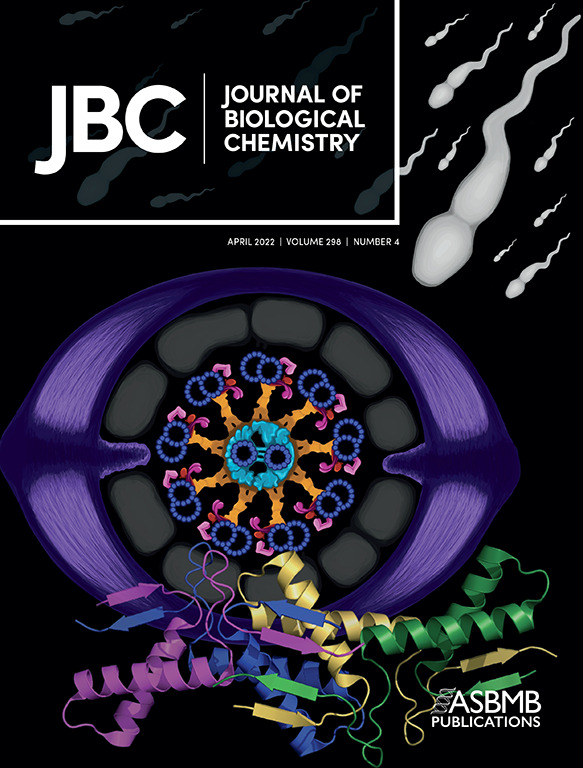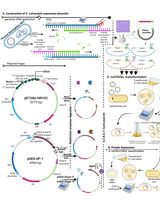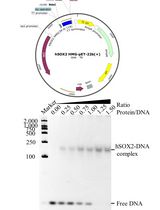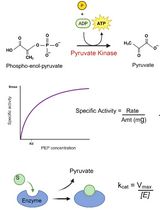- EN - English
- CN - 中文
Expression and Purification of Recombinant Human Mitochondrial RNA Polymerase (POLRMT) and the Initiation Factors TFAM and TFB2M
重组人线粒体RNA聚合酶(POLRMT)及启动因子TFAM和TFB2M的表达和纯化
发布: 2023年12月05日第13卷第23期 DOI: 10.21769/BioProtoc.4892 浏览次数: 2427
评审: Abhilash PadavannilJeremy BirdHassan RasouliAnonymous reviewer(s)
Abstract
Human mitochondrial DNA (mtDNA) encodes several components of oxidative phosphorylation responsible for the bulk of cellular energy production. The mtDNA is transcribed by a dedicated human mitochondrial RNA polymerase (POLRMT) that is structurally distinct from its nuclear counterparts, instead closely resembling the single-subunit viral RNA polymerases (e.g., T7 RNA polymerase). The initiation of transcription by POLRMT is aided by two initiation factors: transcription factor A, mitochondrial (TFAM), and transcription factor B2, mitochondrial (TFB2M). Although many details of human mitochondrial transcription initiation have been elucidated with in vitro biochemical and structural studies, much remains to be addressed relating to the mechanism and regulation of transcription. Studies of such mechanisms require reliable, high-yield, and high-purity methods for protein production, and this protocol provides the level of detail and troubleshooting tips that are necessary for a novice to generate meaningful amounts of proteins for experimental work. The current protocol describes how to purify recombinant POLRMT, TFAM, and TFB2M from Escherichia coli using techniques such as affinity column chromatography (Ni2+ and heparin), how to remove the solubility tags with TEV protease and recover untagged proteins of interest, and how to overcome commonly encountered challenges in obtaining high yield of each protein.
Key features
• This protocol builds upon purification methods developed by Patel lab (Ramachandran et al., 2017) and others with greater detail than previously published works.
• The protocol requires several days to complete as various steps are designed to be performed overnight.
• The recombinantly purified proteins have been successfully used for in vitro transcription experiments, allowing for finer control of experimental components in a minimalistic system.
Keywords: POLRMTBackground
The mitochondrial RNA polymerase (POLRMT) is a DNA-dependent RNA polymerase (RNAP) that transcribes the human mitochondrial DNA (mtDNA), which encodes several protein components of the complexes that carry out oxidative phosphorylation. POLRMT is structurally similar to other single-subunit RNAPs such as T7 phage RNAP (Schwinghammer et al., 2013; Sultana et al., 2017), and current models suggest that POLRMT transcribes short RNA primers used in mtDNA replication initiation (Tan et al., 2022). Considering the central role of POLRMT in cellular metabolism and maintenance of mtDNA, it is not surprising that mutations associated with mitochondrial dysfunction map to POLRMT, such as respiratory chain defects, hypotonia, and global developmental delays (Oláhová et al., 2021).
To start transcription de novo from a promoter sequence, POLRMT requires two initiation factors: transcription factor A (TFAM) and transcription factor B2 (TFB2M), which aid the melting of the promoter sequence and the formation of a stable initiation complex (Hillen et al., 2017; Ramachandran et al., 2017). TFAM is also the mtDNA packaging protein that compacts the mtDNA into structures called nucleoids. While too much TFAM can prevent proteins involved in transcription and other processes from accessing the mtDNA, TFAM is required to bend the upstream promoter region to recruit POLRMT to the promoter site; the underlying mechanisms of this process are yet to be worked out. Published work suggests that post-translational modifications (PTMs) to TFAM, such as acetylation or phosphorylation, do not compromise its function as a transcription factor but make it easier for POLRMT to remove TFAM from DNA, thus increasing transcription processivity through TFAM-compacted DNA (Reardon and Mishanina, 2022).
This protocol describes in detail how to isolate recombinant POLRMT, TFAM, and TFB2M from Escherichia coli in high purity and how to overcome the challenges in achieving high protein yield. These protocols build upon the procedures developed in the Patel lab and others (Yakubovskaya et al., 2014; Ramachandran et al., 2017) and describe the steps in greater detail than in any previously published work to provide access to these resources to a wider community. The resulting proteins can be used to reconstitute human mitochondrial transcription on promoter sequences in vitro, as in prior biochemical and structural studies (Bird et al., 2018; Tan et al., 2022). These proteins can be post-translationally modified to probe the impact of PTMs on their function to fine-tune mitochondrial transcription output (Reardon and Mishanina, 2022). Finally, the protocols can also be applied to express and purify mutant proteins to study the underlying basis of mutations associated with mitochondrial dysfunction.
Materials and reagents
4× Laemmli sample buffer (Bio-Rad, catalog number: 1610747)
10× Tris/Glycine/SDS (Bio-Rad, catalog number: 1610732)
Dithiothreitol (DTT) (Fisher BioReagents, catalog number: BP172-5), see Recipes for preparation
Ethanol (EtOH) (Fisher Scientific, catalog number: 2818500)
Glycerol (Fisher Scientific, catalog number: BP229-1)
HiTrap heparin column (GE Healthcare, catalog number: 17-0407-03)
Hydrochloric acid (HCl) (Fisher Scientific, catalog number: LC149502)
Imidazole (molecular biology grade, > 99%) (Fisher Scientific, catalog number: O3196-500)
Isopropyl-β-D-1-thiogalactopyranoside (IPTG) (Fisher Scientific, catalog number: BP1755100), see Recipes for preparation
LB agar, Miller (Fisher Scientific, catalog number: BP1425-2)
LB broth (LB), Miller, granulated (Fisher Scientific, catalog number: BP9723-2)
Lysozyme (Fisher Scientific, catalog number: BP535-5)
Precision Plus ProteinTM All Blue Prestained Protein Standards (Bio-Rad, catalog number: 1610373)
Protease inhibitor cocktail (PIC) powder (used in this protocol as 1,000× stock and prepared following instructions online: https://www.sigmaaldrich.com/US/en/product/sigma/p2714) (Sigma-Aldrich, catalog number: P2714-1BTL)
Sodium hydroxide (NaOH) pellets (Fisher Scientific, catalog number: S318-500)
β-mercaptoethanol (BME) (Fisher Scientific, catalog number: AC125472500)
Part I: POLRMT purification materials and reagents
Amicon Ultra-15 centrifugal filter units (50K MWCO, 15 mL) (Millipore Sigma, catalog number: UFC905024)
Ammonium sulfate (AS) (Fisher Scientific, catalog number: A702-3)
Ampicillin (Fisher Scientific, catalog number: BP1760-25), see Recipes for preparation
Cytiva CaptoTM DEAE chromatography media (Fisher Scientific, catalog number: 45-002-960) or, if using an FPLC, HiTrap DEAE Fast Flow (Cytiva, catalog number: 17-5154-01)
HisTrap FPLC column (Cytiva, catalog number: 17-3712-06)
Polyethyleneimine (PEI), MN 60,000 50% (Fisher Scientific, catalog number: AC178571000), see Recipes for preparation
Poly-Prep® chromatography columns (Bio-Rad, catalog number: 7311550)
Sodium chloride (NaCl) (Fisher Scientific, catalog number: BP358-212, CAS number: 7647-14-5)
Tris base (Fisher BioReagents, catalog number BP152-1)
Tween 20 (Fisher BioReagents, catalog number: BP337-100)
Part II: TFAM purification materials and reagents
1 kb DNA ladder (NEB, catalog number: N3232S)
4-(2-hydroxyethyl)-1-piperazineethanesulfonic acid (HEPES) (Fisher Scientific, catalog number: BP310-1)
Amicon Ultra-15 centrifugal filter units (3K MWCO, 15 mL) (Millipore Sigma, catalog number: UFC900324)
Ethidium bromide solution, 10 mg/mL (Bio-Rad, catalog number: 1610433)
HisPur Ni-NTA resin (Thermo Scientific, catalog number: 88222)
Kanamycin (Fisher Scientific, catalog number: 611290050), see Recipes for preparation
Potassium chloride (KCl) (molecular biology grade) (Fisher Scientific, catalog number: P217-3)
Sodium chloride (Fisher Scientific, catalog number: BP358-212, CAS number: 7647-14-5)
Part III: TFB2M purification materials and reagents
4-(2-hydroxyethyl)-1-piperazineethanesulfonic acid (HEPES) (Fisher Scientific, catalog number: BP310-1)
Amicon Ultra-4 centrifugal filter units (10K MWCO, 4 mL) (Millipore Sigma, catalog number: UFC801008)
HisPur Ni-NTA resin (Thermo Scientific, catalog number: 88222)
Kanamycin (Fisher Scientific, catalog number: 611290050), see Recipes for preparation
Potassium chloride (KCl) (Fisher Scientific, catalog number: P217-3)
Potassium hydroxide (KOH) (Fisher Scientific, catalog number: P250 500)
Biological materials
Plasmids available upon request
Escherichia coli (E. coli) BL21-CodonPlus (DE3)-RIPL competent cells (Agilent, catalog number: 230280) or
E. coli BL21-CodonPlus (DE3)-RIL competent cells (Agilent, catalog number: 230245)
Optional: E. coli ArcticExpress (DE3) competent cells (Agilent, catalog number: 230192)
Tobacco Etch Virus (TEV) protease (Kapust et al., 2001; Raran-Kurussi et al., 2017)
POLRMT construct in pPROEXHTb. It contains residues 43–1230 [lacking its N-terminal mitochondrial targeting sequence (MTS)] with an N-terminal hexahistidine 6x-His-tag
TFAM construct in pPROEXHTb. It contains residues 43–246 (lacking its N-terminal MTS) with an N-terminal 6x-His-tag and a TEV protease site
TFB2M construct in pT7TEV-HMBP4. It contains residues 20–398 with an N-terminal 6x-His-tag, maltose binding protein (MBP) tag, and a TEV protease site
Solutions
See Recipes for all solutions.
Part I: POLRMT purification
5% Polyethylenimine (PEI) solution pH 7.0
POLRMT Lysis Buffer
POLRMT HisTrap Buffer A
POLRMT HisTrap Buffer B
POLRMT Heparin No Salt Buffer
POLRMT Heparin Buffer A
POLRMT Heparin Buffer B
Part II: TFAM purification and activity test
TFAM Lysis Buffer
TFAM Ni-NTA Buffer A
TFAM Ni-NTA Buffer B
TFAM TEV Cleavage Buffer
TFAM Heparin Buffer A
TFAM Heparin Buffer B
TFAM Storage Buffer (2×)
10× TFAM Binding Buffer
TFAM Electrophoretic Mobility Shift Assay (EMSA) Buffer
Part III: TFB2M Purification
TFB2M Lysis Buffer
TFB2M Ni-NTA Buffer A
TFB2M Ni-NTA Buffer B
TFB2M TEV Cleavage Buffer
TFB2M No Salt Heparin Buffer
TFB2M Heparin Buffer A
TFB2M Heparin Buffer B
Recipes
Common stock solutions
Note: Sterilize all stocks by filtering through a 0.22 μm syringe filter, aliquot into 1 mL portions, and store at -20 °C.
1 M IPTG Stock
2.38 g of IPTG
Dissolve in Milli-Q water and bring the final volume up to 10 mL.
*Add 200 μL of 1 M IPTG per 1 L of cell culture for a final concentration of 0.2 mM IPTG.
Amp stock (100 mg/mL)
1 g of ampicillin
Dissolve in Milli-Q water and bring the final volume up to 10 mL.
Kan stock (25 mg/mL)
0.25 g of kanamycin
Dissolve in Milli-Q water and bring the final volume up to 10 mL.
1 M DTT Stock
1.54 g of DTT
Dissolve in Milli-Q water and bring the final volume up to 10 mL.
Part I: POLRMT Purification
Note: All buffers (except for 5% PEI) are adjusted to pH 7.0 with HCl or NaOH, sterilized with a 0.22 μm filter, and stored at 4 °C. Add BME to the Lysis and HisTrap purification buffers and DTT to the HiTrap heparin purification buffers right before use. Prepare cold, filtered Milli-Q H2O and 20% EtOH to wash and store the FPLC columns after use.
5% PEI solution
Reagent (stock concentration) Final concentration Quantity PEI (50%) 5% 10 mL Milli-Q H2O n/a 90 mL Total 100 mL Adjust pH to 7.0 with HCl when the solution is cold or on ice. No need to filter.
POLRMT Lysis Buffer
Reagent (stock concentration) Final concentration Quantity Tris-HCl (1 M, pH 7.9) 40 mM 10 mL NaCl (3 M) 400 mM 33.3 mL Glycerol (100%) 15% v/v 37.5 mL Tween 20 (100%) 0.1% v/v 0.25 mL EDTA (500 mM) 1 mM 0.5 mL BME* (14.3 M) 5 mM See Note Lysozyme* 1 mg/mL See Note PIC (1,000×)* 1× See Note Milli-Q H2O n/a 168 mL Total 250 mL *Add right before use. Pour 50 mL of the buffer into a conical tube and then add these components (5 mg of lysozyme, 17.5 μL of BME, and 50 μL of PIC) to the tube instead of the entire bottle of buffer. PIC was prepared following instructions online and is used as 1,000× stock: https://www.sigmaaldrich.com/US/en/product/sigma/p2714.
POLRMT HisTrap Buffer A
Reagent (stock concentration) Final concentration Quantity Tris-HCl (1 M, pH 7.9) 40 mM 40 mL NaCl (3 M) 300 mM 100 mL Glycerol (100%) 15% v/v 150 mL Tween 20 (100%) 0.1% v/v 1 mL Imidazole 20 mM 1.36 g BME* (14.3 M) 5 mM 350 μL Milli-Q H2O n/a 707 mL Total 1,000 mL *Add BME right before use.
POLRMT HisTrap Buffer B
Reagent (stock concentration) Final concentration Quantity Tris-HCl (1 M, pH 7.9) 40 mM 20 mL NaCl (3 M) 300 mM 50 mL Glycerol (100%) 15% v/v 75 mL Tween 20 (100%) 0.1% v/v 0.5 mL Imidazole 500 mM 17.02 g BME* (14.3 M) 5 mM 175 μL Milli-Q H2O n/a 353 mL Total 500 mL *Add BME right before use.
POLRMT Heparin No Salt Buffer
Reagent (stock concentration) Final concentration Quantity Tris-HCl (1 M, pH 7.9) 40 mM 4 mL NaCl (3 M) 0 mM n/a Glycerol (100%) 15% v/v 15 mL Tween 20 (100%) 0.1% v/v 0.1 mL EDTA (500 mM) 1 mM 0.2 mL DTT* (1 M) 1 mM 100 μL Milli-Q H2O n/a 81.6 mL Total 100 mL This buffer is used to adjust the salt concentration of the elution from the HisTrap column. *Add DTT right before use.
POLRMT Heparin Buffer A
Reagent (Stock concentration) Final concentration Quantity Tris-HCl (1 M, pH 7.9) 40 mM 40 mL NaCl (3 M) 150 mM 50 mL Glycerol (100%) 15% v/v 150 mL Tween 20 (100%) 0.1% v/v 1 mL EDTA (500 mM) 1 mM 2 mL DTT* (1 M) 1 mM 1,000 μL Milli-Q H2O n/a 756 mL Total 1,000 mL *Add DTT right before use.
POLRMT Heparin Buffer B
Reagent (Stock concentration) Final concentration Quantity Tris-HCl (1 M, pH 7.9) 40 mM 20 mL NaCl (3 M) 1,000 mM 167 mL Glycerol (100%) 15% v/v 75 mL Tween 20 (100%) 0.1% v/v 0.5 mL EDTA (500 mM) 1 mM 1 mL DTT* (1 M) 1 mM 500 μL Milli-Q H2O n/a 236 mL Total 500 mL *Add DTT right before use.
Part II: TFAM purification
Note: All buffers are adjusted to pH 7.5 with HCl or NaOH, sterilized with a 0.22 μm filter, and stored at 4 °C. Prepare cold, filtered Milli-Q H2O and 20% EtOH to wash and store the FPLC columns after use.
TFAM Lysis Buffer
Reagent (stock concentration) Final concentration Quantity Tris-HCl (1 M, pH 7.5) 20 mM 4 mL NaCl (3 M) 200 mM 13.33 mL Glycerol (100%) 15% v/v 30 mL Imidazole 10 mM 0.136 g BME* (14.3 M) 5 mM See Note Lysozyme* 1 mg/mL See Note Protease inhibitor cocktail* (1,000×) 1× See Note Milli-Q H2O n/a 152.47 mL Total 200 mL *Add right before use. We only need 50 mL of the buffer in a conical tube; then, add these components (5 mg of lysozyme, 17.5 μL of BME, and 50 μL of PIC) to the tube instead of the entire bottle of buffer.
TFAM Ni-NTA Buffer A*
Reagent (stock concentration) Final concentration Quantity Tris-HCl (1 M, pH 7.5) 20 mM 20 mL NaCl (3 M) 200 mM 66.65 mL Glycerol (100%) 15% v/v 150 mL Imidazole 10 mM 0.681 g BME* (14.3 M) 5 mM 350 μL Milli-Q H2O n/a 762.35 mL Total 1,000 mL *This buffer is the same as the TFAM Lysis Buffer without lysozyme and PIC. Add BME right before use.
TFAM Ni-NTA Buffer B
Reagent (stock concentration) Final concentration Quantity Tris-HCl (1 M, pH 7.5) 20 mM 20 mL NaCl (3 M) 200 mM 66.65 mL Glycerol (100%) 15% v/v 150 mL Imidazole 500 mM 34.04 g BME* (14.3 M) 5 mM 350 μL Milli-Q H2O n/a 762.35 mL Total 1,000 mL *Add BME right before use.
TFAM TEV Cleavage Buffer
Reagent (stock concentration) Final concentration Quantity Tris-HCl (1 M, pH 7.5) 20 mM 40 mL NaCl (3 M) 300 mM 200 mL Glycerol (100%) 15% v/v 300 mL BME* (14.3 M) 5 mM 700 μL Milli-Q H2O n/a 1,459 mL Total 2,000 mL *Add BME right before use.
TFAM Heparin Buffer A
Reagent (stock concentration) Final concentration Quantity Tris-HCl (1 M, pH 7.5) 20 mM 20 mL NaCl (3 M) 200 mM 66.67 mL Glycerol (100%) 15% v/v 150 mL DTT* (1 M) 1 mM 1,000 μL Milli-Q H2O n/a 762.33 mL Total 1,000 mL *Add DTT right before use.
TFAM Heparin Buffer B
Reagent (stock concentration) Final concentration Quantity Tris-HCl (1 M, pH 7.5) 30 mM 30 mL NaCl (3 M) 1500 mM 500 mL Glycerol (100%) 15% v/v 150 mL DTT* (1 M) 1 mM 1,000 μL Milli-Q H2O n/a 319 mL Total 1,000 mL *Add DTT right before use.
TFAM Storage Buffer (2×)
Reagent (stock concentration) Final concentration Quantity Tris-HCl (1 M, pH 7.5) 80 mM 16 mL NaCl (3 M) 200 mM 13.33 mL DTT* (1 M) 2 mM 400 μL Milli-Q H2O n/a 170.27 mL Total 200 mL *Add DTT right before use.
10× TFAM Binding Buffer
500 mM Tris-HCl pH 8.0
1 M KCl
50 mM MgCl2
1 mM DTT (add right before use)
TFAM EMSA Running Buffer
50 mM Tris-acetate pH 8.0
2.5 mM EDTA
Part III: TFB2M purification
Note: All buffers are adjusted to pH 8.0 with HCl or KOH, sterilized with a 0.22 μm filter, and stored at 4 °C. Use BME for the Lysis and HisTrap buffers and DTT for the HiTrap Heparin column and Storage buffers. Prepare cold, filtered Milli-Q H2O and 20% EtOH to wash and store the FPLC columns after use.
TFB2M Lysis Buffer
Reagent (stock concentration) Final concentration Quantity HEPES-KOH (1 M, pH 8.0) 20 mM 6 mL KCl (3 M) 1 M 100 mL Glycerol (100%) 5% v/v 15 mL Imidazole 10 mM 0.204 g BME* (14.3 M) 5 mM See Note Lysozyme* 1 mg/mL See Note Protease inhibitor cocktail* (PIC, 1,000×) 1× See Note Milli-Q H2O n/a 179 mL Total 300 mL *Add right before use. We only need 50 mL of the buffer in a conical tube; then, add these components (5 mg of lysozyme, 17.5 μL of BME, and 50 μL of PIC) to the tube instead of the entire bottle of buffer.
TFB2M Ni-NTA Buffer A
Reagent (stock concentration) Final concentration Quantity HEPES-KOH (1 M, pH 8.0) 20 mM 20 mL KCl (3 M) 300 mM 100 mL Glycerol (100%) 5% v/v 50 mL Imidazole 20 mM 1.36 g BME* (14.3 M) 5 mM 350 μL Milli-Q H2O n/a 830 mL Total 1,000 mL *Add BME right before use.
TFB2M Ni-NTA Buffer B
Reagent (stock concentration) Final concentration Quantity HEPES-KOH (1 M, pH 8.0) 20 mM 10 mL KCl (3 M) 300 mM 50 mL Glycerol (100%) 5% v/v 25 mL Imidazole 500 mM 17.02 g BME* (14.3 M) 5 mM 175 μL Milli-Q H2O n/a 415 mL Total 500 mL *Add BME right before use.
TFB2M TEV Cleavage Buffer
Reagent (stock concentration) Final concentration Quantity HEPES-KOH (1 M, pH 8.0) 20 mM 40 mL KCl (3 M) 300 mM 200 mL Glycerol (100%) 5% v/v 100 mL BME (14.3 M) * 5 mM 699.3 μL Milli-Q H2O n/a 1,659.3 mL Total 2,000 mL *Add BME right before use.
TFB2M No Salt Heparin Buffer
Reagent (stock concentration) Final concentration Quantity HEPES-KOH (1 M, pH 8.0) 20 mM 4 mL Glycerol (100%) 5% v/v 10 mL EDTA (500 mM) 1 mM 0.4 mL DTT (1 M) * 1 mM 0.2 mL Milli-Q H2O n/a 185.4 mL Total 200 mL *Add DTT right before use.
TFB2M Heparin Buffer A
Reagent (stock concentration) Final concentration Quantity HEPES-KOH (1 M, pH 8) 20 mM 20 mL KCl (3 M) 200 mM 66.67 mL Glycerol (100%) 5% v/v 50 mL EDTA (500 mM) 1 mM 2 mL DTT (1 M) * 1 mM 1 mL Milli-Q H2O n/a 860.33 mL Total 1,000 mL *Add DTT right before use.
TFB2M Heparin Buffer B
Reagent (stock concentration) Final concentration Quantity HEPES-KOH (1 M, pH 8.0) 20 mM 10 mL KCl (3 M) 1.5 M 250 mL Glycerol (100%) 5% v/v 25 mL EDTA (500 mM) 1 mM 1 mL DTT (1 M) * 1 mM 0.5 mL Milli-Q H2O n/a 213.5 mL Total 500 mL *Add DTT right before use.
SDS-PAGE sample recipes
Note: These recipes make 20 μL of each SDS-PAGE sample. Boil samples for 5 min at 95 °C before running and load 9–12 μL per lane. All POLRMT samples can be run on 8%–10% SDS-PAGE. For TFAM and TFB2M, 10%–12% SDS-PAGE would be suitable. We run the gels in 1× Tris/Glycine/SDS buffer and stain with Coomassie.
Uninduced, induced, pellet, lysate, PEI pellet, PEI supernatant, AS pellet, Ni-NTA or HisTrap flowthrough, and wash samples
1.5 μL of sample or scrape a small amount of pellet directly into the microfuge tube
13.5 μL of Milli-Q water
5 μL of 4× Laemmli buffer
Ni-NTA Elution samples, AS supernatant
7.5 μL of sample or small piece of pellet
7.5 μL of Milli-Q water
5 μL of 4× Laemmli buffer
TEV-cleaved sample, HisTrap, and Heparin column fractions
Note: Load as much as possible (at least 12 μL per lane) to visualize very diluted samples
10 μL of sample or small piece of pellet
5 μL of Milli-Q water
5 μL of 4× Laemmli buffer
Laboratory supplies
17 mm × 100 mm culture tubes, 14 mL (VWR, catalog number: 60818-689)
BD disposable syringe, 50 mL (Fisher Scientific, catalog number: 13-689-8)
Biotix 10 μL tips (Fisher Scientific, catalog number: 12-111-021)
Fernsbach culture flasks, 2.8 L (Fisher Scientific, catalog number: 09-552-39)
Membrane filters, 0.22 μm pore size, 47 mm diameter (Fisher Scientific, catalog number: 09-719-2B)
Petri dishes (Fisher Scientific, catalog number: FB0875713)
Pipette tips, microfuge tubes, and low-retention tubes (Genesee Scientific, catalog numbers: 24-282, 23-150RL, 23-165RL, 28-103, 22-281LR)
Serological pipettes, 5, 10, and 25 mL (VWR, catalog numbers: 75816-094, 75816-100, 75816-090)
Syringe filters (0.22 μm pore size, 25 mm diameter) (VWR, catalog number: 76479-024)
Equipment
1 L centrifuge bottles with sealing closure (Thermo Scientific, catalog number: 31411006)
4 L capacity centrifuge (Thermo Scientific, Sorvall LYNX 4000 Superspeed Centrifuge, catalog number: 75006580)
Benchtop centrifuges (Eppendorf, 5910 R, 5425)
Benchtop incubator shaker (Eppendorf, model: New Brunswick Benchtop Incubator Shaker I24)
BioSpectrometer Basic (Eppendorf)
Dialysis tubing, 14,000 MWCO (Sigma-Aldrich, catalog number: D9777-100FT)
Fast protein liquid chromatography (FPLC) system (Bio-Rad, NGC Quest 10 Chromatography System, catalog number: 7880001)
Gel imager (Bio-Rad, model: Gel Doc EZ Imager)
Glass column for Ni-NTA resin (Bio-Rad, Econo-Column Chromatography Column, catalog number: 7371512)
Hot plate stirrer (VWR, catalog number: 97042-674)
Magnetic stir bar (Fisher Scientific, catalog number: 14-513-51)
Reusable bottle top filter unit (Thermo Scientific, Nalgene, catalog number: DS0320-2533)
SDS-PAGE running system (Bio-Rad, Mini-PROTEAN Tetra System)
Sonicator (Qsonica, CL-18 Sonicator Probe)
Software and datasets
Bio-Rad Image Lab (https://www.bio-rad.com/en-us/product/image-lab-software?ID=KRE6P5E8Z)
ImageJ version 1.53e (https://imagej.net/ij/index.html)
Procedure
文章信息
版权信息
© 2023 The Author(s); This is an open access article under the CC BY-NC license (https://creativecommons.org/licenses/by-nc/4.0/).
如何引用
Readers should cite both the Bio-protocol article and the original research article where this protocol was used:
- Hsieh, A., Reardon, S. D., Munozvilla-Cabellon, J. H., Shen, J., Patel, S. S. and Mishanina, T. V. (2023). Expression and Purification of Recombinant Human Mitochondrial RNA Polymerase (POLRMT) and the Initiation Factors TFAM and TFB2M. Bio-protocol 13(23): e4892. DOI: 10.21769/BioProtoc.4892.
- Reardon, S. D. and Mishanina, T. V. (2022). Phosphorylation and acetylation of mitochondrial transcription factor A promote transcription processivity without compromising initiation or DNA compaction. J. Biol. Chem. 298(4): 101815.
分类
分子生物学 > 蛋白质 > 表达
生物化学 > 蛋白质 > 分离和纯化
您对这篇实验方法有问题吗?
在此处发布您的问题,我们将邀请本文作者来回答。同时,我们会将您的问题发布到Bio-protocol Exchange,以便寻求社区成员的帮助。
Share
Bluesky
X
Copy link













